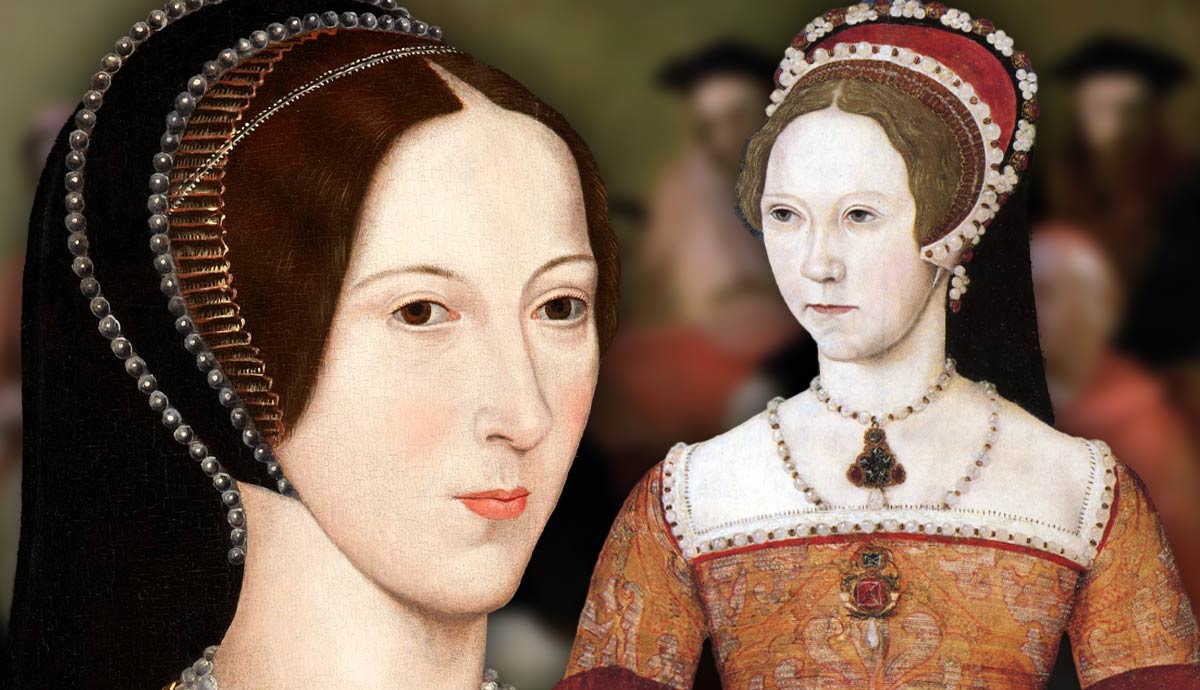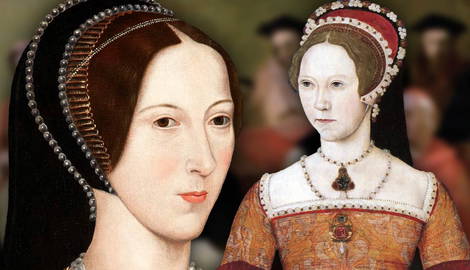
Anne Boleyn is a figure from history whose reputation seems to precede her. Once queen of England, her life and role in the Tudor court catapulted her into common knowledge. Yet, if you were to ask a random person to tell you something about Anne Boleyn, chances are they will think of a commonplace, 500-year-old rumor. “She had six fingers, didn’t she?” Actually — she didn’t. Here are three major rumors about Anne Boleyn, debunked.
1.She Was a Witch

Probably the most well-known rumor about Anne Boleyn is that she was a witch; the infamous proof for this is that she had six fingers on her right hand. What often gets overlooked about this rumor is that its origins are from after Anne died.
In 1585, Anne’s only surviving child with Henry VIII, Elizabeth I, was queen. This was also the year that a Catholic priest named Nicholas Sander wrote in his book, Rise and Growth of the Anglican Schism, that “[Anne] had a projecting tooth under the upper lip, and on her right hand six fingers.”
Sander’s claim about Anne Boleyn and her witchy attributes is the most notable starting point for this rumor, but it was not written under the influence of truth. Religious circumstances are what motivated Sander, who, as a Catholic, was not in favor of the Protestant Elizabeth I ruling over him. He hated her, and he hated her mother Anne, whom he blamed for England having broken away from Roman Catholicism.
If Anne hadn’t come onto the scene, Henry might never have gone through what is described as the “King’s Great Matter” and kept England as a Catholic country. This is what angered Sander, and so he set out to smear Anne’s reputation, in order to try and dismantle Elizabeth’s power and legitimacy as a queen.

Somehow, the lies of one man leaked into common belief and became fact hundreds of years after his book was published. However, this rumor can easily be disregarded when thinking about it in the context of the time. At the time, being found guilty of witchcraft could result in being hanged; any signs of sorcery were taken very seriously.
If Anne truly had six fingers, she would never have even been employed as one of Katherine of Aragon’s ladies in waiting; let alone go on to marry the king of England. An additional finger, as well as the aforementioned “projecting tooth,” would have been regarded at the very least as deformities, and would have prevented her from advancing anywhere near as far as she did at court.
It is a rumor that has sadly stuck with Anne for as long as she has been remembered. But it is a false one and has been officially discredited by highly regarded Tudor historians and writers since it came into existence. There is also no evidence from the time when Anne was alive that proves or even suggests that the rumors were true, which alone should be enough to discredit them. As for Nicholas Sander, he never knew Anne Boleyn and would have been only six years old when she died.
2. She Demanded to Be Queen

Another commonly held belief about Anne Boleyn is that she was essentially a homewrecker, seeking out the married Henry VIII and seducing him for her own political gain. She was painted as power-hungry, with claims that she refused his attempted seduction unless he divorced Katharine and made her queen instead.
The truth of the courtship between Anne Boleyn and Henry VIII is less about a woman seeking power at whatever cost and more about a powerful man refusing to take no for an answer. Henry sent many letters to Anne, in which he expressed his love and desire, as well as his refusal to give up on gaining her affections. Anne had to be careful about how she handled the situation she found herself in, as offending the king had dire consequences. Henry was the one who relentlessly pursued her for years, whilst still married to Katharine of Aragon. Somehow though, Anne is the scapegoat for the decay of Henry’s relationship with Katherine, and not the man responsible.
An important detail to frame Anne and Henry’s relationship with is that Anne wasn’t the first Boleyn daughter to have caught the eye of Henry VIII. In fact, her older sister Mary Boleyn had previously been Henry’s mistress. While it is not known exactly when their alleged affair began, or for how long it lasted, it is known that Henry attended Mary’s wedding to William Carey, in February 1520. It is also commonly suggested that Henry was the father of Mary’s two children, but the king never acknowledged them as his, unlike with another former mistress Elizabeth Blount, whose son Henry he officially recognized as his; earning him the name Henry FitzRoy.

The fact that her own sister was once Henry’s mistress would have made Anne extra cautious when she became the one Henry set his sights on. She feared a similar fate of being a mere temporary source of entertainment for the king, to eventually be tossed aside at his pleasure. While it became a rumor that Anne refused any relationship with Henry unless he made her queen, it is more likely that she was doing this to delay having to officially engage with the king.
Again, when considering the reality of the situation, this is the more logical explanation. Divorce was not something done commonly, if at all, in Tudor times. Would Anne have really expected that a request to be Henry’s wife and queen of England would be taken seriously? Katherine was a royal-born Spanish princess, part of a powerful royal dynasty, and Anne was just a lady of the English nobility. In terms of status, Katherine had quite a bit more than Anne. Anne wasn’t unaware of this and she knew that it would have been an unrealistic request for her to make of Henry. If she did refuse his advances unless he made her queen, it would have seemed more likely that he would simply forget about Anne and find an easier option.
Anne’s initial refusal to engage in any relationship with Henry VIII has been twisted to fit an ulterior narrative that frames Anne as scheming and power-obsessed. It is not an unheard-of phenomenon for independently-minded women to have their intentions misrepresented to undermine them. Unfortunately for Anne, this reality plagued the latter half of her life, when it seemed everyone was out to get rid of her.
3. She Was Horrible to Princess Mary

It is frequently reported that when Anne Boleyn was finally made queen, she was a stereotypical evil stepmother towards Mary Tudor, Henry’s daughter with Katherine of Aragon. While it would be wrong to say there was no tension between Anne and Mary, the blame for this does not sit solely with Anne, and there is evidence to show that Anne did try to reach out to Mary and reconcile their relationship. Sadly, the idea of the evil-stepmother seems more interesting, and so the lines between the rumor and reality became blurred.
The political, social, and religious effects from Henry’s divorce from Katharine of Aragon were felt far and wide. For some, its effects were felt harder than others, and it completely changed the life of Mary Tudor. Mary, like her mother — and up until the divorce, her father too — was very passionate about and dedicated to the Roman Catholic church. She believed in the notion that royals were chosen by God to rule on earth, and that this was something no humans could intervene with. She believed absolutely in her mother’s place as queen of England, and that it was a title that was given to her from the divine. As a princess, Mary was also chosen by God to follow in her parents’ footsteps as sovereign. However, this worldview that she had ingrained in her since birth was turned upside down when Anne Boleyn arrived in her life.

Henry VIII and Anne Boleyn were married on the 25th of January 1533. It was from here that Mary was declared illegitimate, lost her succession rights, and was forbidden from seeing her mother. When Elizabeth Tudor was born in September 1533, the situation worsened, with Mary being forced to recognize her half-sister as a princess and wait on her as if she were a servant. Mary was angry, upset, confused, and betrayed, and became very ill because of the stress her new life was bringing her.
A lot of this is blamed on the way Anne Boleyn treated Mary as her stepdaughter. An example is that during a visit to her daughter Elizabeth at Hatfield House in 1534, where Elizabeth and Mary were both staying, Anne reportedly demanded that Mary come and “honour her as Queen.” Mary agreed to see her but refused to recognize her as queen. The only queen to Mary was her mother.
The fact is that their relationship was never exactly going to be easy or harmonious. Yes, Anne may have been harsh or forceful toward Mary at times. But Mary was her father’s daughter, inheriting his stubbornness and determination. Her total refusal to even try and get along with Anne, despite attempts at reconciliation from the latter, naturally was frustrating to Anne and could explain why she would at times be unfair towards her stepdaughter. However, Mary’s misery was truly in the hands of her father, who had referred to Mary as his “greatest enemy.” He was the king, and he was the one calling the shots when it came to Mary’s life after his divorce from her mother, yet Anne Boleyn is vilified as the evil stepmother who was Henry VIII’s puppet master.

Most of what we know about Mary’s life in these years comes from the writings of Charles V’s ambassador to England, Eustace Chapuys. He was a firm supporter of both Katherine of Aragon and Mary and did not accept Henry’s divorce and subsequent remarriage to Anne Boleyn. The allegiances of Chapuys are clear. He is said to have despised Anne and refused to even say her name. So, to take his record of the relationship between Anne and Mary as the impartial truth would be naïve. Any chance to undermine, discredit, and tarnish Anne and her reputation would have been taken by Chapuys, with honesty not being the priority of his writings.
Anne Boleyn and Mary Tudor’s relationship was the one that was arguably doomed from the start. A young princess having her mother, status, and privileges snatched away was not going to take kindly to the woman who to her was totally responsible. They were both to blame for their poor relationship, but what unites them is that they were both victims of Henry and his tyrannical ways. Henry eventually sent Anne to her death in 1536, and his relationship with Mary scarcely improved afterward, showing that he was the true problem all along. Neither Mary nor Anne got what they deserved, and they both suffered due to Henry VIII.

Anne Boleyn was a highly targeted and controversial figure, who made many angry and jealous just by existing. Just like today, rumors and lies were an easy way for powerful men such as Nicholas Sander or Eustace Chapuys to discredit her for their own gain or agenda. While many of the rumors about her were never actually proven as true, they have still managed to survive history and merge from fiction into fact. However, as more people endeavor to discover the truth, historical figures like Anne will have their stories told as they truly were, and rumors that have followed Anne Boleyn’s memory for centuries are having their cracks exposed.









